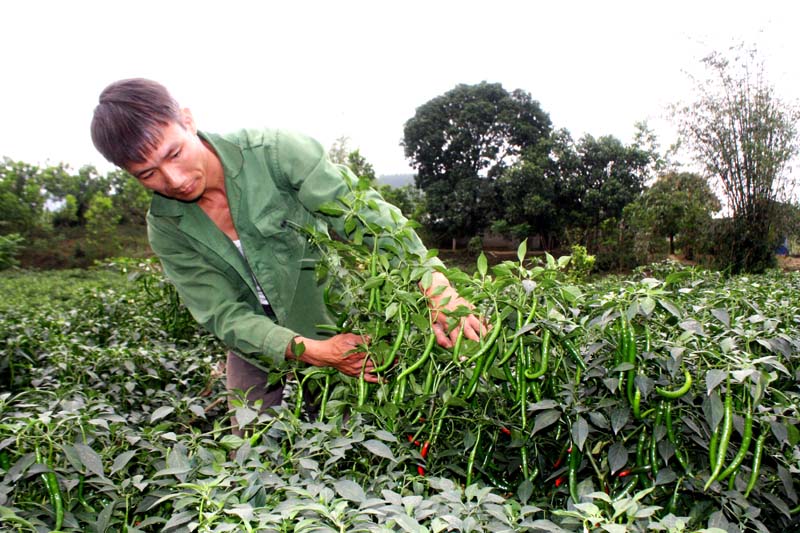
(HBO) – Good earnings from the cultivation of chilli plants have helped people in An Lac commune (Lac Thuy district) find the answer to the question of what plant is best for them.

Bumper chilli harvests brought joy to Pham
Hung’s family and the chilli growers in An Lac’s An Phu village.
Quach Cong Ninh, Chairman of the An Lac
People's Committee, said that following good earnings of the first crop, local
farmers expanded the area under the plant from 3 to 5 hectares. Chilli plants
grow healthily, offering stable output, so everyone is very optimistic.
We accompanied Vu Ngoc Thuong, a local
agricultural official, in a visit to a model garden of growing chillies for
export in An Phu hamlet. Chilli
plants in the 1,140 m2 garden of
farmer Pham Hung were laden with fruits, ready to be picked. Hung grew the
hybrid chilli No. 7 (a hybrid chilli type of Chian), which yields finger-sized fruit
and matches the soil of An Lac. Hung said: "In the first crop, we cultivated 720
m2, but only half of the area bore fruit, as we lacked technical knowledge.
This crop, we doubled the plantation scale. Now we have experience and
knowledge, and our chillies have grown two or three times faster compared to
last year.”
"When we master the technique, it is
not difficult to cultivate the plant," said Hung. "The most important
thing for us is there is a company that provide us with seeds, technical
support and buy our chillies. If market prices increase, the company will raise
their purchase prices, but when market prices are low, it keeps the price at at
least 5,000 VND per kg. At that price, growing chilli plants is already much
more profitable than planting corn and cassava.”
From the beginning of the year, Mr. Hung's
family has had two bumper harvests, and sold the fruit at between 5,000 to
6,000 VND per kg. With an average one harvest every six months, each chilli plan
can yield over 2 kg of fruit.
Apart from Hung’s family, An Phu also has
9 households growing chilli. "Employees of Chili Vietnam Ltd. (which
signed contracts with local chili growers) regularly check and provide
technical support to farmers. If diseases occur, farmers will report to the
company for prompt measures. In addition to An Phu, some other hamlets in the
commune also have potential to follow the model," said Vu Ngoc Thuong.
"Chilli plants are suitable to local
soils, thus output and earnings are guaranteed. In the 2018-20 winter crop, An
Lac will expand the total area under the plant to 10 hectares. In addition to
citrus farming, we have concluded that chilli trees would help people secure a
stable source of income at home," stressed Quach Cong Ninh, chairman of
the An Lac People's Committee.
According to data from the Hoa Binh Provincial Party Committee, the industrial production index for the first six months of 2025 is estimated to have increased by 20% compared to the same period last year. This marks the highest year-on-year growth rate for this period since 2020.
In the first six months of 2025, Hoa Binh province’s export turnover was estimated at 1.145 billion USD, marking an 18.11% increase compared to the same period in 2024. Import turnover was estimated at $ 804 million, a 17.15% increase, which helped the province maintain a positive trade balance.
The lives of the ethnic minority farmers in Tan Lac district have gradually improved thanks to the new directions in agricultural production. This is a testament to the collective strength fostered through the professional associations and groups implemented by various levels of the district’s Farmers’ Union.
With the motto the "product quality comes first,” after nearly one year of establishment and operation, Muong village’s Clean Food Agricultural and Commercial Cooperative, located in Cau Hamlet, Hung Son Commune (Kim Boi district), has launched reputable, high-quality agricultural products to the market that are well-received by consumers. The products such as Muong village’s pork sausage, salt-cured chicken, and salt-cured pork hocks have gradually carved out a place in the market and they are on the path to obtaining the OCOP certification.
In the past, the phrase "bumper harvest, rock-bottom prices" was a familiar refrain for Vietnamese farmers engaged in fragmented, small-scale agriculture. But today, a new spirit is emerging across rural areas of Hoa Binh province - one of collaboration, organisation, and collective economic models that provide a stable foundation for production.
Maintaining growing area codes and packing facility codes in accordance with regulations is a mandatory requirement for agricultural products to be eligible for export. Recently, the Department of Agriculture and Environment of Hoa Binh province has intensified technical supervision of designated farming areas and packing facilities to safeguard the "green passport" that enables its products to access international markets.



